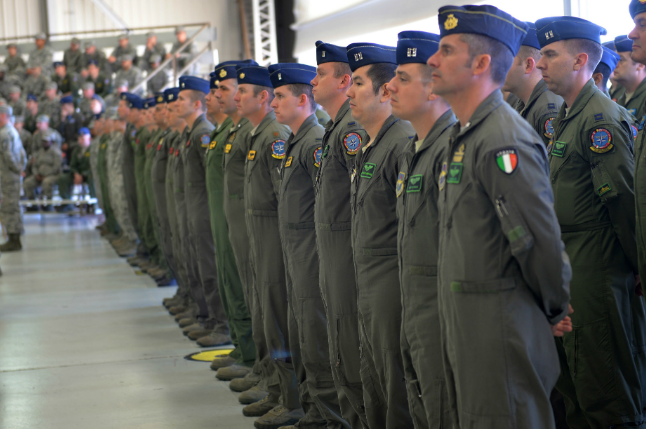
US and foreign pilots assigned to the 80th Flying Training Wing stand at parade rest in a hangar at Sheppard AFB, Texas, that supports the Euro-NATO Joint Jet Pilot Training program. Air Force photo by SSgt. Kyle Gese.
SAN ANTONIO—The Air Force and NATO’s joint pilot training wing is testing a new training program, heavy on technologies such as virtual reality, in an effort to increase the number of USAF and international pilots trained as well as the overall quality of training.
The 80th Flying Training Wing’s Euro-NATO Joint Jet Pilot Training Program (ENJJP) at Sheppard AFB, Texas, in November stood up a strategic initiatives directorate in November, which will begin testing its ideas with a T-6 class in February, said Lt. Col. Jason Turner, the director of strategic initiatives at the 80th FTW.
Similar to the Pilot Training Next program in nearby Austin, the Sheppard program relies heavily on consumer technology and virtual reality, all at a relatively cheap cost, Turner said at the Military Flight Training USA conference here. For example, the directorate purchased 600 iPad Mini electronic flight bags, 10 T-6 virtual reality devices, 10 T-38 and T-6 switchable mixed reality devices with the ability to GPS track the simulated flight and provide a 360-degree video of in-flight maneuvers, and live air traffic control in the simulated flight.
A steering committee will meet in March to determine the effectiveness of the program, Turner said, noting it will only take “three months to deliver massive changes to the way we do business.”
If approved, by December the wing can begin scaling the program, Turner said.
It is just a start, and the wing has a lot more it wants to do but is currently not able to, so it is turning to industry for help. Some of the things they want are biometric feedback on the virtual systems to gauge how a pilot feels about the maneuvers, a cloud-based training system, a gamified syllabus to promote competition between pilots, and an app for feedback between students, among others. This would have to come cheap, however, because we “don’t have millions,” just smaller levels of funding from squadron innovation and commander’s readiness funds, he said.
The wing has 201 aircraft—125 T-38s and 77 T-6s—and 1,300 personnel to produce half of the USAF pilots core and the entirety of some other nation’s pilot forces. These aircraft and personnel are “extremely busy,” flying 56,000 flight hours in Fiscal 2018 alone, he said.
Going forward, the wing needs to do more. The Air Force has a highly publicized pilot shortage and Air Education and Training Command has been tasked to increase the throughput, however, that isn’t just an American problem as NATO countries are also facing their own shortages. “We’re down pilots and we have to produce more … Every air force is limited in the pilots that they’re bringing,” Turner said.
For many partner nations, the fleet on Sheppard’s ramp is larger than their entire air forces, Turner said. Additionally, half of the partner nations have purchased F-35s, so the wing needs to produce fifth generation-ready pilots using aircraft that are ancient, he said. This means the wing needs to bring on the T-X as soon as possible to provide “absolute, top-notch training” he said.